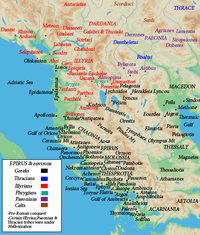- Kichyro
-
Kichyros (Cichorus, Cichyrus; Κίχυρος), later called Ephyra (Ἐφύρα), was the capital of ancient Thesprotia, according to the myth built by the Pelasgian leader Thesprotos. Thucydides describes it as situated in the district Elaeatis in Thesprotia, away from the sea.[1] At its site is the famous Necromanteion (Νεκρομαντεῖον "Oracle of the Dead"). First settled during the Bronze Age and resettled in the 14th century BC by colonists most probably from Chaonia and the west Peloponnese region. Located in Elis of Thesprotis[2] the city is about 800 m north of the junction of the Kokkytos River with the Acheron, and about 4.5 km E of the bay of Ammoudia. Near it was the outlet into the sea of the Acherusian Lake. Strabo (7.7.5) gives the same information and adds that in his time Ephyra was called Kichyros. The name had been changed from Ephyra back to the more ancient name about 200 years earlier.[3]
Contents
In mythology
Neoptolemos was said to have landed at Kichyros (Ephyra) on his return from Troy (Pind. Nem. 7.37-39) and Odysseus came there later to get poison for his arrows (Od. 1 .259f). Theseus and Perithoos came to snatch away Persephone, wife of Aidoneus King of Ephyra. These were none other than Persephone and Hades, the gods of the underworld, who had a shrine and an oracle at Ephyra.[4] Heracles subjugated Ephyra and fathered a child by Princess Astyoche, Tlepolemus, who became king of Rhodes.[5] Thyestes came there looking for his brother, Atreus. Atreus was not there, but the dauthter of Thyestes, Pelopia, was there, and Thyestes, not recognizing her, took her as a wife. Their union produced Aegisthus.[6]
Information on the location
The site of Ephyra is confirmed by the excavation of the ancient oracle of the dead, Necromanteion, on the hill of Agios Ioannis near the village of Mesopotamos, 150 m N of the junction of the Kokkytos with the Acheron. The remains of three ancient wall circuits are preserved on the limestone nearby hill of Xylokastro. The finds within the acropolis, chiefly sherds of local pottery of the Bronze Age and Mycenaean sherds, together with the worship of the chthonic goddess Persephone. After the surrender of the Elean colonies in Kassopaia to Philip II of Macedon in 343-342 BC, (Dem. 7.32) and their subjection to the Thesprotians, Ephyra appears to have reverted to its original name, Kichyros, which had been kept alive in some neighboring Thesprotian settlement.[7] Some finds, chiefly pottery of the 1st c. B.C., confirm the statement of Pausanias (1.17.5) that Kichyros was in existence in his time.
Ancient accounts
The Thesprotia Kichyros/Ephyra appears to be the town mentioned in two passages of the Odyssey (i. 259, ii. 328). The Ephyri, mentioned in a passage of the Iliad (xiii. 301), were supposed by Pausanias to be the Thesprotians inhabitants of the town.[8] but Strabo maintained that the poet referred to the Thessalian Ephyra (Strab. ix. p. 442). Some commentators even supposed the Ephyra on the Selleeis[9] to be the Thesprotian town, but Strabo expressly maintains that Homer alludes in these passages to the Eleian town.[10] Pausanias represents Cichyrus as the capital of the ancient kings of Thesprotia, where Theseus and Peirithous were thrown into chains by Aidoneus; and its celebrity in the most ancient times may also be inferred from a passage of Pindar.[11]
Notes
- ^ For a map of this region in NW Greece, see Olalla, Pedro. Mythological Atlas of Greece. Athens: Road Editions, 2002, map 20.
- ^ Note that this is not Peloponnesian Elis
- ^ Olalla, op.cit. p. 39.
- ^ Pausanias 1.17.4-5, 9.36.3; Plut. Theseus 31.35.
- ^ Olalla, op.cit., p. 161.
- ^ Olalla, op.cit. p. 89
- ^ Kichyros, the former Ephyra: Strabo 7.7.5, 8.3.5.
- ^ Pausanias ix. 36.3.
- ^ Homer, Iliad ii. 659, xv. 531.
- ^ Strabo vii. p. 328,; comp. viii. p. 338.
- ^ Pausanias i. 17. 4; Pind. Nem. vii. 55.; William Martin Leake, Northern Greece, vol. iii. p. 7, vol. iv. pp. 53, 175.
External links
See also
Categories:- Ancient Greek cities
- Former populated places in Greece
- Geography of ancient Epirus
- Epirotic mythology
- Archeological sites in the Periphery of Epirus
Wikimedia Foundation. 2010.

